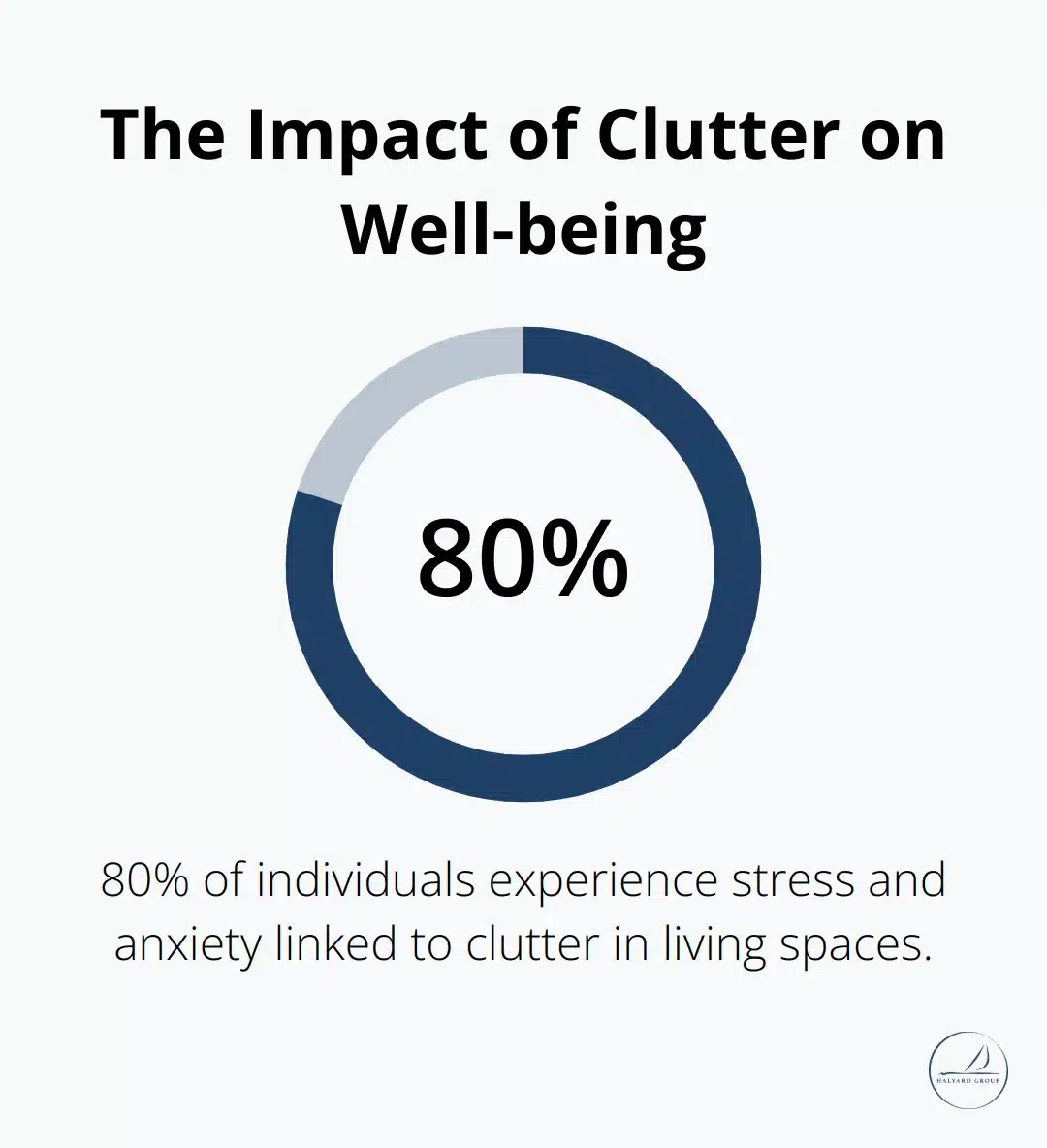When it comes to finding the perfect home, square footage often takes centre stage. But is it really the best measure of a living space’s comfort and functionality?
At The Halyard Group, we’ve seen countless families surprised by how differently homes with similar square footage can feel.
This disconnect between numbers on paper and real-life experience is what we’ll explore in this post, uncovering the factors that truly make a house feel like home.
Beyond Numbers: The Real Feel of Home Spaces
The Illusion of Space: Layout Matters
When families search for the perfect home, square footage often takes centre stage. However, raw numbers don’t always tell the whole story. A 2,000-square-foot house can feel cramped, while a 1,500-square-foot home might seem spacious and airy. The floor plan of a home plays a crucial role in how spacious it feels. Open concept designs can make a smaller home feel much larger. This highlights the importance of flow and connectivity between rooms over sheer size.
Natural Light: The Space Amplifier
Natural light transforms how we perceive space. Homes with large windows, skylights, or strategically placed mirrors can feel significantly more expansive than their square footage suggests. Natural lighting in the home can impact the emotional subjective wellbeing of its inhabitants. This effect can make a substantial difference in how comfortable and spacious a home feels to its occupants.
Storage Solutions: The Hidden Space Savers
Clever storage dramatically affects how spacious a home feels. Built-in shelving, under-stair storage, and multi-functional furniture can free up floor space and reduce clutter. A recent study found that over 80% of individuals experience stress and anxiety directly linked to clutter in their living spaces. Effective storage solutions (like pull-out pantries or hidden closets) can transform a cluttered space into an organized oasis.

The Psychology of Space Perception
Our perception of space extends beyond physical dimensions. Factors such as colour schemes, furniture arrangement, and even scent can influence how we experience a room. Light colours and mirrors can create an illusion of more space, while dark colours can make a room feel cozy (but potentially smaller). The arrangement of furniture can either obstruct or enhance flow, significantly impacting our spatial perception.
Functionality: Making Every Square Foot Count
The true measure of a home’s size lies in its functionality. A well-designed 1,500-square-foot home with thoughtful layout and storage solutions might serve a family better than a poorly planned 2,500-square-foot space. Consider how each area of the home will be used and whether it meets your family’s specific needs. Multi-purpose rooms (such as a home office that doubles as a guest room) can maximize the utility of available space. If you’re unsure where to start, contact the Halyard Group for a walk through of what kind of layout would best support your lifestyle.
As we explore the disconnect between square footage and perceived space, it becomes clear that the perfect home isn’t just about size-it’s about how well it fits your family’s needs and aspirations. In the next section, we’ll examine the psychological factors that influence our perception of space and how you can use this knowledge to your advantage when choosing a home.
How Your Mind Shapes Your Space
The Illuminating Impact of Light and Colour
Light and colour profoundly affect our spatial perception. Natural light can significantly impact people’s perceptions of happiness and sadness, with settings that have abundant daylight influencing these emotions. When natural light is scarce, layered lighting (combining ambient, task, and accent lights) creates depth and dimension, enhancing the sense of space.
Colour choices significantly influence spatial perception. Light colours, particularly cool tones like soft blues and greens, make walls appear to recede, creating an illusion of more space. Warm or dark colours can make a room feel cozier (but potentially smaller). The Pantone Colour Institute reports that a monochromatic colour scheme can create a sense of continuity and openness in a space.
The Vertical Dimension: Why Ceiling Height Matters
Ceiling height plays a surprisingly important role in our perception of space. Research published in the Journal of Consumer Research found that rooms with higher ceilings (10 feet or more) associated with feelings of freedom and abstract thinking, while lower ceilings (8 feet or less) promoted more focused, detail-oriented thinking.
Homes with varying ceiling heights often feel more dynamic and spacious. For instance, a home with 9-foot ceilings in main living areas and standard 8-foot ceilings in bedrooms can create a sense of grandeur in shared spaces while maintaining coziness in private areas.

Furniture and Clutter: The Space Shapers
The arrangement of furniture and the presence of clutter significantly affect how we perceive space. Moreover, poorly arranged furniture can make even large rooms feel cramped and dysfunctional.
To maximize perceived space, consider these practical tips:
- Use multi-functional furniture to reduce the number of pieces needed.
- Create clear pathways through rooms to improve flow and perceived openness.
- Implement a regular decluttering routine to maintain a sense of spaciousness.
- Choose furniture that fits the scale of the room – oversized pieces can make spaces feel smaller.
The Psychology of Open Spaces
Open concept designs have gained popularity for good reason. They promote a sense of openness and greater traffic flow, often involving some combination of kitchen, living, and dining areas. This design approach aligns with our psychological need for freedom and movement within our living spaces.
However, the effectiveness of open concepts depends on individual preferences and lifestyle needs. Some families thrive in open layouts, while others prefer more defined spaces for privacy and focused activities. The key lies in finding a balance that suits your family’s unique dynamics and daily routines.
As we move forward, we’ll explore practical strategies to maximize perceived space in your home, regardless of its actual size. These tips will help you transform any living area into a space that feels expansive and welcoming.
How to Expand Your Home’s Perceived Space
Creating a sense of spaciousness in your home doesn’t always require knocking down walls or moving to a larger property. With some clever strategies, you can significantly enhance the perceived space in your current home. Here’s how you can make your living areas feel more expansive and inviting.
Declutter and Organize
The first step to maximize perceived space is to declutter. A study by the National Association of Professional Organizers found that 54% of Americans feel overwhelmed by clutter, and 78% have no idea what to do with it. Start by going through each room and remove items you no longer need or use. For the items you keep, invest in smart storage solutions. Under-bed storage containers, over-door organizers, and floating shelves can help keep surfaces clear and floors open.

Try to implement the “one in, one out” rule to maintain a clutter-free environment. For every new item you bring into your home, remove an old one. This practice not only keeps your space organized but also encourages mindful consumption.
Harness the Power of Light and Mirrors
Lighting plays a key role in how spacious a room feels. According to the Lighting Research Centre, rooms with ample natural light are perceived as up to 10% larger than poorly lit spaces. To maximize natural light, keep windows unobstructed and use sheer curtains instead of heavy drapes.
Strategically placed mirrors can dramatically increase the sense of space. A large mirror opposite a window reflects light and creates the illusion of another room beyond. The Interior Design Institute suggests that mirrors can make a room feel up to twice its actual size when used effectively.
Choose Furniture Wisely
The right furniture can make or break the perceived spaciousness of a room. Opt for pieces with legs that allow you to see the floor underneath, creating a sense of openness. Multi-functional furniture can serve multiple purposes without taking up extra space.
Scale is important when selecting furniture. Oversized pieces can make a room feel cramped, while furniture that’s too small can look out of place. Measure your space carefully and choose items that fit comfortably with room to move around.
Use Colour and Texture Strategically
Colour choices significantly influence spatial perception. Light colours don’t necessarily make walls appear to recede or create an illusion of more space. Warm or dark colours can make a room feel cozier (but potentially smaller). The Pantone Colour Institute reports that a monochromatic colour scheme can create a sense of continuity and openness in a space.
Texture can also play a role in expanding perceived space. Smooth surfaces reflect more light and can make a room feel larger, while rough textures absorb light and can make a space feel cozier. Try to balance these elements to create the desired effect in each room.
Adopting a minimalist mindset can also help in expanding your home’s perceived space. This approach not only eliminates visual clutter but also enhances natural light and airflow, creating a calm and stress-free environment.
Final Thoughts
Square footage alone doesn’t determine a home’s livability. The true measure of a home lies in how it feels and functions for your family. Natural light, clever storage, and thoughtful design create a sense of spaciousness that transcends raw dimensions.
We encourage families to look beyond square footage figures when assessing potential homes. Focus on how the space flows, accommodates daily routines, and makes you feel. Consider the layout, natural light, and potential for smart storage solutions (these elements often impact your day-to-day life more than extra square feet).
At The Halyard Group, we understand that finding the right home involves more than numbers. Our approach considers your unique lifestyle, preferences, and needs to guide you towards homes that feel right when you walk through the door. We help you find a home that truly fits your family, considering factors like neighbourhood dynamics and proximity to amenities.





